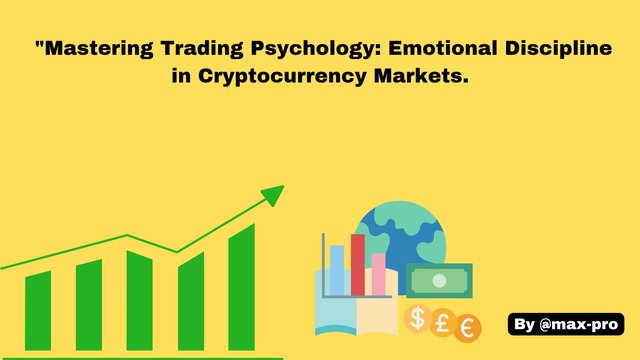 Made by Canva
Made by Canva
Assalamu Alaikum friends. Wishing everyone good health. Hope you all are well. By God's grace I am fine too. Today I am here to participate in a wonderful learning competition organized by SteemitCryptoAcademy community. The Topic of this contest is "Mastering Trading Psychology: Emotional Discipline in Cryptocurrency Markets. So this is a very important competition where we can learn some important things. Below are some questions that I will answer correctly. So let's get started.
Question 1 : Identifying Emotional Triggers in Trading, Discuss common emotional triggers (e.g., fear, greed, overconfidence) that affect traders. Provide examples of how these emotions manifest during market movements.
Emotional triggers are very important in trading as they have a major impact on traders' decision making. Here is a detailed discussion of common emotional triggers and their effects.
| Fear :- |
|---|
- Fear is an emotion that affects traders fearing losses in the market.
Example:
If the price of a stock falls rapidly in the market, many traders may sell their shares out of fear, even though it may be a temporary decline.
When trading without a "stop-loss", the fear is intensified, because the trader is not sure where the stop loss will be.
| Greed :- |
|---|
- Greed forces traders to take risky decisions in the hope of greater profits.
| Example | When the price of a stock rises, the trader thinks it will rise further and instead of taking profit at the right time, holds it unnecessarily. |
|---|
- "Over-leveraging" (investing with debt) is an example of greed, where the trader takes large risks for excess profits.
| Overconfidence :- |
|---|
- Overconfidence causes traders to overestimate their own skills.
| Example | If a trader makes a few profitable trades in a row, they may think that all their decisions will be correct in the future. As a result, they may take risky trades without adequate research. |
|---|
Overconfidence can lead to "position sizing" errors, where traders increase risk by investing large amounts.
How these emotions manifest in the market:
| Panic Selling | Due to fear, traders start selling their shares in fear of losses, which causes the market to fall further. |
|---|---|
| Overinvesting in Bull Markets | Greed causes traders to buy shares at high prices resulting in a "bubble". |
| Holding Bind Trades | Traders hold losing stocks due to overconfidence. Expect it to grow again even though in reality it doesn't. |
Strategies to deal with these emotions:
Trading Plan : Setting predetermined stop-loss and profit targets.
Journal Keeping : Keep a trading journal to analyze emotional decisions.
Focusing : Trying to control emotions through mindfulness or meditation.
If traders can control these emotions properly, they can succeed in long-term profitable trading.
Question 2 : Overcoming Psychological Barriers
Share techniques to overcome psychological barriers like fear of missing out (FOMO), loss aversion, or overconfidence. Use examples relevant to Steem/USDT trading.
Strategies to overcome psychological barriers
Traders face various mental hurdles during trading which prevent them from making the right decisions. Here are common mental blocks like fear of missing out (FOMO), loss aversion, and overconfidence, and strategies to overcome them.
| Fear of Missing Out (FOMO) :- |
|---|
FOMO is a state of mind where traders feel they are missing out on a big opportunity and make hasty decisions.
| Steem/USDT example | If the price of Steem is going up fast and you see a lot of people buying it, you might think "I better buy now, or the profits will be lost." In reality, the price may have reached a peak and will soon begin to decline. |
|---|
Strategy :
Following Trading Plan: Trading according to your trading strategy. Be sure to do technical analysis (TA) without rushing because the price is rising.
Acceptance of Missing: Remembering that not all opportunities can be captured. Even if an opportunity is missed, new opportunities will come.
Setting entry points: Set buy zone and sell zone on volatile trades like Steem/USDT. For example, wait to buy at certain support levels.
| Loss Aversion :- |
|---|
Loss aversion means traders don't want to accept losses and stick to trades that generate more losses.
| Steem/USDT example | You bought Steem/USDT at 0.25 USDT, but the price dropped to 0.20 USDT. Instead of accepting the loss and closing the trade, you hope that the price will rise again. But in reality it decreased further. |
|---|
Strategy :
Using stop-loss: Set a stop-loss before starting the trade. For example, the trade will be closed when the price is 0.23 USDT.
Loss Acceptance Mindset: Losses are normal in trading. Accepting small losses saves from big losses.
Using the risk-reward ratio: Determine the ratio of potential profit to loss on a trade, such as 1:2 (the chance of two units of profit versus one unit of loss).
| Overconfidence :- |
|---|
Overconfidence means the trader takes excessive risks and makes wrong decisions due to his previous success.
Steem/USDT example :
If you made a profit on a few previous Steem trades, you might think, "I always make the right decision," and trade with a larger lot size this time. But if the market suddenly goes in the opposite direction, there is a big loss.
Briefly arranged strategy:
| Mental block | Steem/USDT example | strategy |
|---|---|---|
| FOMO | buying too much when the price is rising | following the trading plan and taking entries by looking at the buy zone. |
| Loss aversion | sticking to loss trades and not using stop-losses | setting stop-losses and determining risk-reward ratio. |
| Overconfidence | taking big losses after continuous gains, taking big losses | limiting risk and analyzing each trade. |
Question 3 : Developing a Trading Routine
Propose a daily or weekly trading routine that includes psychological preparation, such as journaling trades, setting realistic goals, and practicing mindfulness.
Now I show daily trading routine, including psychological preparation.
| Pre-Trading Preparation (Daily Morning): |
|---|
| Market Analysis: |
|---|
Check previous day's market review and today's trend.
Determine the support-resistance level of Steem/USDT.
Setting realistic goals :
- Set a daily profit-loss target (example: profit 2%, loss 1%).
| Mental Preparation: |
|---|
- 5-10 minutes of meditation or breathing control exercises.
| Resolve to control emotions | "I will stick to my trading plan." |
|---|
| Trading Duration (Market Hours): |
|---|
| Follow the trading plan | Trade only at your designated entry and exit points. Focus on avoiding FOMO. |
|---|---|
| Risk Management | Setting stop-loss and take-profit on each trade. |
| Taking a break | Take a 5-10 minute break every 1-2 hours. Keep body and mind refreshed. |
| Post-Trading Analysis (End of Day): |
|---|
| Trade Journaling | Record today's trades (entry/exit points, profit/loss, trading emotions). |
|---|
- Example: "Profit is 1.5% on Steem/USDT trade, but hastily entered once due to FOMO."
| Self-Review | Analyze which trades were successful and which decisions went wrong. |
|---|---|
| Mindfulness Practice | End the day by meditating for 5 minutes. This will create mental preparation for the next day. |
| Weekly Trading Routine: |
|---|
| Weekly Analysis | Review the entire week's trades. |
|---|
Identify patterns of successful trades and wrong decisions.
Resetting goals :
- Set new goals for the coming week (example: further reducing risk or specific profit goals).
| Personal Improvement: |
|---|
- Practice new techniques to reduce stress (meditation, journaling, exercise).
Question 4 : Case Study on Emotional Trading
Analyze a hypothetical or real-life scenario where emotions led to a significant trading mistake. Explain how emotional discipline could have prevented the loss.
| Case Study | "Max-Pro" Emotional Trading Mistake |
|---|
| Scenario: |
|---|
Max-Pro is a trader trading the Steem/USDT pair. He made big profits in some recent trades and became overconfident in his abilities. Then he heard an important news that the price of Steem could go up.
| Facts: |
|---|
Entry : Max-Pro buys Steem/USDT in large lot sizes at $0.30 without hesitation, as he thinks the price will go up to $0.40.
FOMO Trigger : When the price of Steem reaches $0.32, he buys more, because he thinks the market may go higher.
Market Reversal : Steem price quickly drops to $0.26 due to sudden major selling pressure. As Max-Pro's trade was without a stop-loss, he held the trade in frustration, hoping that the market would bounce back.
| Emotional Mistakes: |
|---|
Overconfidence : Consistent profits made him arrogant and he took large lot trades without research.
FOMO (Fear of Missing Out) : Feeling the urge to buy more as prices rise.
Loss Aversion : Holding trades without using stop-losses and refusing to accept losses.
| Results: |
|---|
| Financial losses | He suffered huge losses due to the collapse of Steem/USDT. |
|---|---|
| Psychological Effects | He becomes depressed and loses confidence in trading. |
| How mental discipline can help: |
|---|
Follow the trading plan :
Setting a stop-loss would have limited the loss to $0.28. Adherence to the planned risk-reward ratio could have avoided major losses.
| Control FOMO: |
|---|
While listening to market news, technical analysis (TA) should have been done before taking entry. A healthy mental preparation would prevent him from buying unnecessarily.
| Lot Size Management: |
|---|
Risk amount should be kept between 1-2% of trading capital. Instead of trading in large lot sizes, he used to analyze the market with small positions.
| Mindfulness Practice: |
|---|
By practicing meditation and trade journaling to control emotions, he could foresee the wrong side of the decision.
Max-Pro's case studies show that mental discipline and planning are the keys to success in trading. Controlling emotions can reduce the chances of losses and lead to profitable trading in the long run.
Question 5 : Building Resilience in Volatile Markets
Discuss how to build mental resilience to handle high-stress trading environments, including techniques for staying focused during volatile conditions.
Mental Resilience is critical to success in high-pressure trading environments. It helps the trader to remain steady and focused even in volatile markets. Below are step-by-step strategies for building emotional resilience.
Market research and create trading plans. Determine support, resistance levels and entry-exit points. Create Risk-to-Reward Ratio of potential risk and profit. Set realistic goals. Determine what amount of profit or loss is acceptable per day or week. Follow the principle of small gain, small loss. Practice deep breathing for 5-10 minutes before starting trading as a mental preparation. Remind yourself that "I will stick to the trading plan and control emotions."
| Steps in brief :- |
|---|
Step strategy
| Trading plan | entry, exit, stop-loss determination. |
|---|---|
| Take a "Pause" in Emotion Control | Meditation and Decision Making. |
| Set realistic goals | small and achievable targets. |
| Trading journal | record and analyze every trade. |
| Take physical and mental care | exercise, sleep and rest. |
| Mindfulness practice | the practice of meditation and focus. |
| Keeping the big picture in mind | pursuing long-term goals. |
| Break from trade | recover mental energy. |
So I think following these steps in volatile markets will maintain mental stability and make it easier to make sound decisions even in volatile situations.
Conclusion :- Maintaining resilience and mental discipline in volatile markets is the key to trading success. A well-structured trading routine, setting realistic targets, using stop-losses and controlling emotions make it possible to make sound decisions in volatile situations. Mindfulness practices, trade journaling and healthy routines improve traders' ability to cope with stress by boosting mental energy. By following these strategies, traders can maintain focus even in high-stress markets and remain in profitable positions for the long term.

So I am Inviting my lovely Steemian friends @robin42, @ulfatulrahmah, @selina1 to Participate in this Competition.





https://x.com/maxpro1412/status/1869043008957730993?t=1BGg4RYUL70JoIpS5D2WRQ&s=19
Downvoting a post can decrease pending rewards and make it less visible. Common reasons:
Submit
Terima kasih atas undangan untuk saya
Downvoting a post can decrease pending rewards and make it less visible. Common reasons:
Submit
🥰🥰🥰🥰
Downvoting a post can decrease pending rewards and make it less visible. Common reasons:
Submit